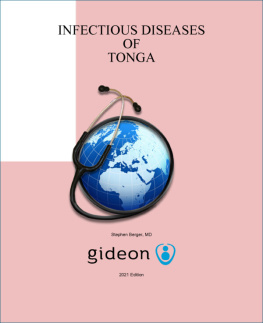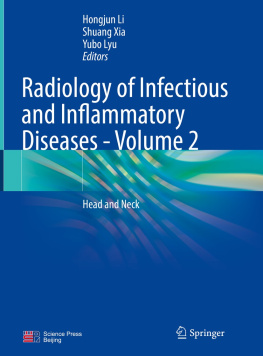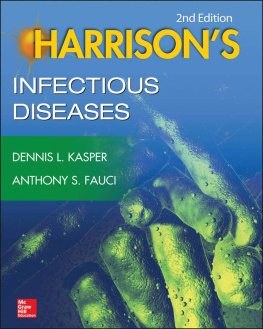Notice
Medicine is an ever-changing science. As new research and clinical experience broaden our Despite dire warnings that we are approaching the end of the antibiotic era, the incidence of antibiotic-resistant bacteria continues to rise. The proportions of penicillin-resistant Streptococcus pneumoniae, hospital-acquired methicillin-resistant Staphylococcus aureus (MRSA), and vancomycin-resistant Enterococcus (VRE) strains continue to increase. Community-acquired MRSA (cMRSA) is now common throughout the world. Multiresistant Acinetobacter and Pseudomonas are everyday realities in many of our hospitals. The press is now warning the lay public of the existence of dirty hospitals. As never before, it is critical that health care providers understand the principles of proper anti-infective therapy and use anti-infective agents judiciously. These agents need to be reserved for treatable infectionsnot used to calm the patient or the patients family. Too often, patients with viral infections that do not warrant anti-infective therapy arrive at the physicians office expecting to be treated with an antibiotic. And health care workers too often prescribe antibiotics to fulfill those expectations. Physicians unschooled in the principles of microbiology utilize anti-infective agents just as they would more conventional medications, such as anti-inflammatory agents, anti-hypertensive medications, and cardiac drugs. They use one or two broad-spectrum antibiotics to treat all patients with.

Copyright 2014 by McGraw-Hill Education. All rights reserved. Except as permitted under the United States Copyright Act of 1976, no part of this publication may be reproduced or distributed in any form or by any means, or stored in a data base or retrieval system, without the prior written permission of the publisher.
ISBN: 978-0-07-178926-4
MHID: 0-07-178926-X
The material in this eBook also appears in the print version of this title: ISBN: 978-0-07-178925-7, MHID: 0-07-178925-1.
E-book conversion by codeMantra
Version 1.0
All trademarks are trademarks of their respective owners. Rather than put a trademark symbol after every occurrence of a trademarked name, we use names in an editorial fashion only, and to the benefit of the trademark owner, with no intention of infringement of the trademark. Where such designations appear in this book, they have been printed with initial caps.
McGraw-Hill Education products are available at special quantity discounts to use as premiums and sales promotions or for use in corporate training programs. To contact a representative, please visit the Contact Us pages at www.mhprofessional.com.
TERMS OF USE
This is a copyrighted work and McGraw-Hill Education and its licensors reserve all rights in and to the work. Use of this work is subject to these terms. Except as permitted under the Copyright Act of 1976 and the right to store and retrieve one copy of the work, you may not decompile, disassemble, reverse engineer, reproduce, modify, create derivative works based upon, transmit, distribute, disseminate, sell, publish or sublicense the work or any part of it without McGraw-Hill Educations prior consent. You may use the work for your own noncommercial and personal use; any other use of the work is strictly prohibited. Your right to use the work may be terminated if you fail to comply with these terms.
THE WORK IS PROVIDED AS IS. McGRAW-HILL EDUCATION AND ITS LICENSORS MAKE NO GUARANTEES OR WARRANTIES AS TO THE ACCURACY, ADEQUACY OR COMPLETENESS OF OR RESULTS TO BE OBTAINED FROM USING THE WORK, INCLUDING ANY INFORMATION THAT CAN BE ACCESSED THROUGH THE WORK VIA HYPERLINK OR OTHERWISE, AND EXPRESSLY DISCLAIM ANY WARRANTY, EXPRESS OR IMPLIED, INCLUDING BUT NOT LIMITED TO IMPLIED WARRANTIES OF MERCHANTABILITY OR FITNESS FOR A PARTICULAR PURPOSE. McGraw-Hill Education and its licensors do not warrant or guarantee that the functions contained in the work will meet your requirements or that its operation will be uninterrupted or error free. Neither McGraw-Hill Education nor its licensors shall be liable to you or anyone else for any inaccuracy, error or omission, regardless of cause, in the work or for any damages resulting therefrom. McGraw-Hill Education has no responsibility for the content of any information accessed through the work. Under no circumstances shall McGraw-Hill Education and/or its licensors be liable for any indirect, incidental, special, punitive, consequential or similar damages that result from the use of or inability to use the work, even if any of them has been advised of the possibility of such damages. This limitation of liability shall apply to any claim or cause whatsoever whether such claim or cause arises in contract, tort or otherwise.
Dedication
To my parents, Ann and Wayne Southwick, and children Ashley, Peter, Robyn, and Karli. And finally to my beautiful wife Kathie Southwick for her loving encouragement and continual support.
Contents
Contributors
Bernard Hirschel, M.D.
Professor of Medicine
Division of Infectious Diseases
University of Geneva
Geneva, Switzerland
P. Daniel Lew, M.D.
Professor of Medicine, and Chief of Infectious Diseases and Chairman of Medicine Subspecialties
University of Geneva
Geneva, Switzerland
Frederick S. Southwick, M.D.
Professor of Medicine
Division of Infectious Diseases
University of Florida College of Medicine
Gainesville, Florida
Sankar Swaminathan, M.D.
Don Merrill Rees Presidential Endowed Chair
Professor of Medicine
Chief of Infectious Diseases
University of Utah School of Medicine
Salt Lake City, Utah
Preface
The challenges of infectious diseases are daunting. As our world shrinks, person-to-person spread of influenza and coronavirus has the potential to cause pandemics. The overuse of antibiotics continues to increase the prevalence of highly resistance bacteria. Increasing numbers of patients receive prosthetic devices that subsequently become infected. New immunosuppressive treatments of patients with connective tissue diseases and inflammatory bowel disease increase the risk of opportunistic infections. HIV remains with us and thanks to multiple antiretroviral medications, these patients are experiencing nearly normal life spans increasing the number of HIV-infected patients requiring continued care.
How do medical students, physician assistants, nurse practitioners, and physicians learn this important subspecialty? The textbooks on infectious diseases are generally over 1000 pages in length. However, the average clinician does not have time to read these books in their entirety. There are Internet products that offer detailed descriptions of each individual infectious disease. However, these products offer a fragmented approach that makes a full understanding of the field difficult. Infectious Diseases: A Clinical Short Course concisely covers the key areas of infectious diseases and is designed to be read in 30 days, the usual duration of a clinical elective. At the beginning of each chapter, the estimated time required to read each chapter is included to allow readers to budget their time. To stimulate the readers attention, each chapter begins with a series of guiding questions. These questions are followed by an estimate of the potential severity of each disease to provide the less experienced clinician with a sense of how quickly he or she should be initiating treatment. Actual clinical cases are included for every major disease to link the facts to real patients. Key points are summarized in text boxes to reinforce the most important facts, and allow the reader to quickly review each topic. This tool is particularly effective for reviewing board examinations.











